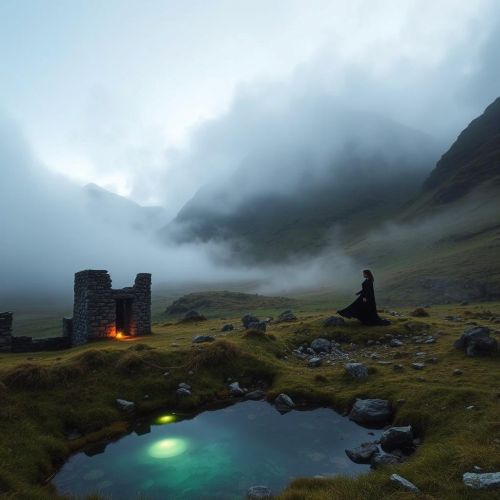Tintagel Castle : The Arthurian Birthplace
At a glance
| Description | |
|---|---|
| Mythology | Arthurian Mythology |
| Country | United Kingdom |
| Closest airport | Newquay Cornwall Airport (NQY) |
| Type | Constructed |
| Accessibility | 09/10 |
Introduction
Perched dramatically on the windswept cliffs of North Cornwall, Tintagel Castle is a site where history and legend merge in spectacular fashion. Overlooking the roaring Atlantic Ocean, the castle ruins, clifftop bridge, and surrounding landscape tell stories that span centuries. Archaeological discoveries trace the site’s occupation back to the late Roman and early medieval periods, when Tintagel was a thriving settlement and trading hub between Britain and the Mediterranean. Luxury goods such as amphorae and fine pottery found at the site suggest that local rulers wielded considerable power and wealth, making Tintagel a center of influence long before the medieval castle was built. Today, Tintagel Castle remains one of Britain’s most iconic historic landmarks, attracting visitors from across the world who seek both its tangible ruins and its mythical reputation.
Connection with Mythology
Tintagel Castle is inseparable from the legends of King Arthur, thanks to Geoffrey of Monmouth’s Historia Regum Britanniae, written in the 12th century. Geoffrey immortalized Tintagel as the place where Uther Pendragon, disguised by Merlin’s magic, fathered Arthur with Igraine, the Duchess of Cornwall. While the story is myth rather than fact, it forever tied Tintagel to Arthurian lore. Later medieval texts elaborated on the idea, with William Worcestre in the 15th century even naming Tintagel as Arthur’s birthplace.
The mythological resonance of Tintagel does not end there. The tragic medieval romance of Tristan and Iseult also situates Tintagel as the court of King Mark of Cornwall, Tristan’s uncle. These overlapping legends reinforced Tintagel’s role as a symbolic stage for themes of love, betrayal, and destiny. Beneath the ruins lies Merlin’s Cave, a sea-carved cavern that enhances the site’s magical atmosphere, while modern additions like the bronze sculpture of King Gallos serve as reminders of Tintagel’s place in the living imagination of Arthurian mythology.
Ways to Get There
Tintagel Castle may be set in a remote part of Cornwall, but visitors have several options to reach it.
By car, the journey from London takes about four and a half hours via the M4, M5, and A30. From Exeter, the drive is roughly 90 minutes. Since there is no parking directly at the castle, visitors must use car parks in Tintagel village, located within walking distance of the entrance.
For those traveling by public transport, Bodmin Parkway is the nearest train station, around 19 miles away. From there, buses connect through Wadebridge and Camelford before reaching Tintagel. Local bus routes, including the 95 service, also link Tintagel with nearby towns such as Bude and Newquay. For longer journeys, Newquay Cornwall Airport is about an hour’s drive, offering flights from major UK cities.
Cyclists can also plan their route through the National Cycle Network, which provides scenic approaches across Cornwall’s rugged countryside. No matter the route, the journey to Tintagel rewards travelers with stunning coastal views and the sense of entering a landscape steeped in history and myth.
What to Look For
Exploring Tintagel Castle is as much about atmosphere as it is about the ruins themselves. The 13th-century stronghold built by Richard, Earl of Cornwall, stretches across both the mainland and a jagged island separated by a natural chasm. Visitors can see the remnants of defensive walls, the Great Hall, and smaller domestic buildings scattered across the site.
One of the most striking features today is the footbridge, completed in 2019, which reconnects the mainland and island as they once were in medieval times. Crossing the bridge not only makes access easier but also offers unparalleled views of the cliffs and ocean.
At low tide, Merlin’s Cave becomes accessible, where waves echo through the cavern and reinforce the site’s mythological aura. Archaeological finds on the island—including high-quality tableware, glassware, and amphorae imported from the Mediterranean between the 5th and 7th centuries—show Tintagel’s role in international trade during the early medieval period. Recent excavations have even uncovered evidence of a possible royal palace complex, confirming that Tintagel was once a seat of power.
Modern visitors can also enjoy the life-sized bronze figure of King Gallos, a symbolic representation of Arthur that stands watch over the cliffs, blending art with myth in an unforgettable coastal setting.
Need a place to stay? Book your hotel room now!
Importance in cultural history
Tintagel Castle holds a unique place in Britain’s cultural memory because it bridges the gap between tangible history and imaginative legend. The medieval fortress built by Earl Richard in the 1230s was less a military necessity and more a monument to the Arthurian stories already popular at the time. By commissioning a castle at such a challenging location, Richard was harnessing the symbolic power of Tintagel to reinforce his own authority and connection to legendary kingship.
In the centuries that followed, Tintagel’s ruins became a source of inspiration for poets, artists, and novelists. Alfred Lord Tennyson’s Idylls of the King drew directly on its legends, while Thomas Hardy wrote his play The Famous Tragedy of the Queen of Cornwall at Tintagel in Lyonnesse after visiting the site. Romantic artists and antiquarians often portrayed Tintagel as a haunting ruin set against the dramatic Cornish coast, reinforcing its reputation as a place where history dissolves into myth.
Today, Tintagel is managed by English Heritage, ensuring both its preservation and accessibility. It remains a key symbol of Cornish identity and a reminder of how storytelling can shape the way people perceive landscapes and monuments. The castle’s enduring allure lies in its ability to embody both fact and fantasy, making it a cultural landmark of national importance.
Best time to travel
The best time to experience Tintagel Castle is during the late spring and early autumn months, when the weather is milder, the sea views are often at their clearest, and visitor numbers are lower. April, May, June, and September are ideal for those who prefer quieter visits and more comfortable exploration of the coastal paths.
Summer, from late June through August, brings warmer temperatures and longer daylight hours, but it is also the busiest period due to school holidays. Visitors during this time should book tickets in advance and be prepared for crowds, especially on the footbridge and coastal trails.
Winter, though atmospheric, is less reliable for travel due to high winds, heavy rain, and slippery paths. Access to Merlin’s Cave and parts of the headland can also be limited by weather conditions. For the best overall experience, a shoulder-season visit balances good weather with fewer crowds, allowing travelers to take in Tintagel’s dramatic beauty at a slower pace.
No matter the season, sturdy footwear and weatherproof clothing are essential, as the Cornish coast is famously unpredictable. Yet even in stormy conditions, Tintagel Castle retains its mystique, offering visitors the sense of stepping into a world where myth and history are forever entwined.
Source
English Heritage. (n.d.). Tintagel Castle: History and Legend. https://www.english-heritage.org.uk/visit/places/tintagel-castle/history-and-legend/
Medieval Chronicles. (n.d.). 10 Mysteries Of Tintagel Castle: A Journey Through Time And Arthurian Legend. https://www.medievalchronicles.com/medieval-legends-myths-and-tales/10-mysteries-of-tintagel-castle-a-journey-through-time-and-arthurian-legend/
Nunn, L. (2025, January 20). Tintagel Travel Guide 2025: Castles, Coastal Walks & King Arthur’s Legacy. Forbes. https://www.forbes.com/sites/lewisnunn/2025/01/20/the-ultimate-guide-to-tintagel/
Wikipedia. (n.d.). Tintagel Castle. Retrieved from https://en.wikipedia.org/wiki/Tintagel_Castle
Poage, S. (2023, September 17). Tintagel: Historical or Legendary Birthplace of King Arthur?. Retrieved from https://www.seanpoage.com/2023/09/17/tintagel-historical-or-legendary-birthplace-of-king-arthur/
Tastes Of History. (2023, July 26). Dispelling Some Myths: Tintagel and King Arthur. Retrieved from https://www.tastesofhistory.co.uk/post/dispelling-some-myths-tintagel-and-king-arthur
The Great Cornish Outdoors. (2022, September 25). Tintagel Castle, Cornwall: The Legend of Merlin and King Arthur. Retrieved from https://thegreatcornishoutdoors.com/tintagel-castle/
King Arthur Way. (2020, August 21). Tintagel – King Arthur Way. Retrieved from https://kingarthurway.wordpress.com/tintagel-arthurian-legend/
BBC. (2022, February 24). The wild island shaped by legend. Retrieved from https://www.bbc.com/travel/article/20160602-the-wild-island-shaped-by-legend
Wilderness England. (2023, April 18). Spotlight: Tintagel Castle. Retrieved from https://wildernessengland.com/blog/tintagel-castle/
Ancient Origins. (2019, December 18). Tintagel Castle: Arthurian Legend Mixes with True History. Retrieved from https://www.ancient-origins.net/ancient-places-europe/tintagel-castle-and-legendary-conception-king-arthur-006831
Britannica. (2025, September 11). Tintagel Castle | History, Legends, & Facts. Retrieved from https://www.britannica.com/topic/Tintagel-Castle
Frequently Asked Questions
Lorem ipsum dolor sit amet, consectetur adipiscing?
Lorem ipsum dolor sit amet, consectetur adipiscing elit. Praesent convallis vestibulum justo, ac tincidunt nunc vehicula quis. Nullam id dolor quis orci malesuada feugiat. Curabitur aliquet libero at urna ullamcorper, ac ultricies nulla dapibus.
Lorem ipsum dolor sit amet, consectetur adipiscing?
Lorem ipsum dolor sit amet, consectetur adipiscing elit. Praesent convallis vestibulum justo, ac tincidunt nunc vehicula quis. Nullam id dolor quis orci malesuada feugiat. Curabitur aliquet libero at urna ullamcorper, ac ultricies nulla dapibus.
Lorem ipsum dolor sit amet, consectetur adipiscing?
Lorem ipsum dolor sit amet, consectetur adipiscing elit. Praesent convallis vestibulum justo, ac tincidunt nunc vehicula quis. Nullam id dolor quis orci malesuada feugiat. Curabitur aliquet libero at urna ullamcorper, ac ultricies nulla dapibus.
Lorem ipsum dolor sit amet, consectetur adipiscing?
Lorem ipsum dolor sit amet, consectetur adipiscing elit. Praesent convallis vestibulum justo, ac tincidunt nunc vehicula quis. Nullam id dolor quis orci malesuada feugiat. Curabitur aliquet libero at urna ullamcorper, ac ultricies nulla dapibus.
Lorem ipsum dolor sit amet, consectetur adipiscing?
Lorem ipsum dolor sit amet, consectetur adipiscing elit. Praesent convallis vestibulum justo, ac tincidunt nunc vehicula quis. Nullam id dolor quis orci malesuada feugiat. Curabitur aliquet libero at urna ullamcorper, ac ultricies nulla dapibus.









